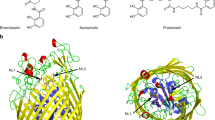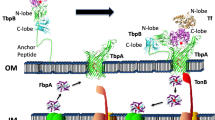Abstract
The outer membrane receptor for ferrioxamines (FoxA Erw ) of Erwinia herbicola (Pantoea agglomerans) was cloned from a cosmid gene bank and partially sequenced. A comparison of the partial amino acid sequence of FoxA with the amino acid sequence of FoxA Yer from Yersinia enterocolitica revealed a high sequence homology. A functional analysis of FoxA and FoxA receptors cloned into a Fhu-negative background (HK97) revealed that ferrioxamines are recognized at very low concentrations (< 10 pmoles) in growth promotion bioassays. A collection of ferrioxamine derivatives containing varying chain lengths and ether bridges within the molecule was also accepted. However, the three ether containing ferrioxamine (Et ) behaved differently in the two FoxA receptors. Coprogen was also recognized to a certain extent, whereas ferrichromes were completely excluded from the FoxA receptors, confirming that coprogens share some structural similarities with the ferrioxamines. FoxA mutants (FM13) of Erwinia herbicola obtained by ferrimycin selection showed no uptake of Fe-labelled ferrioxamine E and B any more, while the transport of coprogen and ferrichrome was unaffected or even slightly increased. © Rapid Science 1998
Similar content being viewed by others
References
Altschul SF, Gish W, Miller W, Myers EW, Lipman DJ. 1990 Basic local alignment search tool. J Mol Biol 215, 403–410.
Bäumler AJ, Hantke K. 1992 Ferrioxamine uptake in Yersinia enterocolitica: Characterization of the receptor protein FoxA. Molec Microbiol 6, 1309–1321.
Berner I, Winkelmann G. 1990 Ferrioxamine transport mutants and the identification of the ferrioxamine receptor protein (FoxA) in Erwinia herbicola (Enterobacter agglomerans). BioMetals 2, 197–202.
Berner I, Konetschny–Rapp S, Jung G, Winkelmann G. 1988 Characterization of ferrioxamine E as the principal siderophore of Erwinia herbicola (Enterobacter agglomerans). BioMetals 1, 51–56.
Berner I, Greiner M, Metzger J, Jung G, Winkelmann G. 1991a Identification of enterobactin and linear dihy-droxybenzoylserine compounds by HPLC and ion spray mass spectrometry (LC/MS and MS/MS). BioMetals 4, 113–118.
Berner I, Yakirevitch P, Libmann J, Shanzer A, Winkelmann G. 1991b Chiral linear hydroxamates as biomimetic analogues of ferrioxamine and coprogen and their use in probing siderophore-receptor specificity in bacteria and fungi. BioMetals 4, 186–191.
Braun V. 1981 Escherichia coli cells containing the plasmid ColV produce the iron ionophore aerobactin. FEMS Microbiol Lett 11, 225–228.
Braun V. 1995 Energy-coupled transport and signal transduction through the Gram-negative outer membrane via TonB-ExcB-ExbD-dependent receptor proteins. FEMS Microbiol Reviews 16, 295–307.
Braun V, Hantke K. 1997 Receptor-mediated bacterial iron transport. In: Winkelmann G, Carrano CJ, eds. Transition Metals in Microbial Metabolism.Amsterdam: Harwood Academic Publishers; 81–116.
Delcour AH. 1997 Function and modulation of bacterial porins: insights from electrophysiology. FEMS Microbiol Lett 151, 115–123.
Drechsel H, Winkelmann G. 1997 Iron chelation and siderophores. In: Winkelmann G, Carrano CJ eds. Transition Metals in Microbial Metabolism.Amsterdam: Harwood Academic Publishers; 1–49.
Feistner GJ, Ishimaru C. 1996 Proferrioxamine profiles of Erwinia herbicola and related bacteria. BioMetals 9, 337–344.
Hossain MB, Jalal MAF, Benson BA, Barnes CL, van der Helm D. 1987 Structure and conformation of two coprogen-type siderophores: neocoprogen I and neocoprogen II. J Am Chem Soc 109, 4948–4954.
Huschka H, Jalal MAF, van der Helm D, Winkelmann G. 1986 Molecular recognition of siderophores in fungi: Role of iron-surrounding N-acyl residues and the peptide backbone during membrane transport in Neurospora crassa. J Bacteriol 167, 1020–1024.
Kachadourian R, Dellagi A, Laurent J, et al. 1996 Desferrioxamine-dependent iron transport in Erwinia amylovora CFBP1430: cloning of the gene encoding the ferrioxamine receptor FoxR. BioMetals 9, 143–150.
Killmann H, Braun V. 1992 An aspartate deletion mutation defines a binding site of the multifunctional FhuA outer membrane receptor of Escherichia coli. J Bacteriol 174, 3479–3486.
Konetschny-Rapp S, Jung G, Raymond KN, Meives J, Zähner H. 1992 Solution thermodynamics of the ferric complexes of new desferrioxamine siderophores obtained by directed fermentation. J Am Chem Soc 114, 2224–2230.
Leong SA, Winkelmann G. 1998 Molecular biology of iron transport in fungi. In: Sigel A, Sigel H, eds. Metal Ions in Biological Systems, Vol 35. New York: Marcel Dekker Inc; 147–186.
Meiwes J, Fiedler HP, Zähner H, Konetschny-Rapp S, Jung G. 1990 Production of desferrioxamine E and new analogues by directed fermentation and feeding fermentation. Appl Microbiol Biotechnol 32, 505–510.
Meyer JM, Van VT, Stintzi A, Berge O, Winkelmann G. 1995 Ornibactin production and transport properties in strains of Burkholderia vietnamiensis and Burkholderia cepacia (formerly Pseudomonas cepacia). BioMetals 8, 309–317.
Neilands JB, Ericson TJ, Rastetter WH. 1981 Stereo-specificity of the ferric enterobactin receptor of Escherichia coli K12. J Biol Chem 256, 3831–3832.
Newton SM, Allen JS, Cao Z, et al. 1997 Double mutagenesis of a positive charge cluster in the ligand-binding site of the ferric enterobactin receptor, FepA. Proc Natl Acad Sci USA 94, 4560–4565.
Quiocho FA, Ledvina PS. 1996 Atomic structure and specificity of bacterial periplasmic receptors for active transport and chemotaxis: variation of common themes. Mol Microbiol 20, 17–25.
Rabsch W, Winkelmann G. 1991 The specificity of bacterial siderophore receptors probed by bioassays. BioMetals 4, 244–250.
Reissbrodt R, Rabsch W, Chapeaurouge A, Jung G, Winkelmann G. 1990 Isolation and identification of ferrioxamines G and E in Hafnia alvei. BioMetals 3, 54–60.
Sambrook J, Fritsch EF, Maniatis T. 1989 Molecular Cloning: A Laboratory Manual (2nd edn.) Cold Spring Harbour, N.Y.: Cold Spring Harbour Laboratory Press.
Sauer M, Hantke K, Braun V. 1990 Sequence of the fhuE outer membrane receptor gene of Escherichia coli K12 and properties of mutants. Mol Microbio 4, 427–437.
Winkelmann G. 1979 Evidence for stereospecific uptake of iron chelates in fungi. FEBS Lett 97, 43–46.
Winkelmann G. 1997 Stereoselective recognition of microbial iron chelates (siderophores) In: Trautwein A-X, ed. DFG, Bioinorganic Chemistry, Transitions Metals in Biology and their Coordination Chemistry.Weinheim: Wiley–VCH; 107–118.
Winkelmann G, Braun V. 1981 Stereoselective recognition of ferrichrome by fungi and bacteria. FEMS Microbiol Lett 11, 237–241.
Winkelmann G, Carrano CJ, eds. 1997 Transition Metals in Microbiol Metabolism. Amsterdam: Harwood Academic Publisher.
Author information
Authors and Affiliations
Rights and permissions
About this article
Cite this article
Deiss, K., Hantke, K. & Winkelmann, G. Molecular recognition of siderophores: A study with cloned ferrioxamine receptors (FoxA) from Erwinia herbicola and Yersinia enterocolitica . Biometals 11, 131–137 (1998). https://doi.org/10.1023/A:1009230012577
Issue Date:
DOI: https://doi.org/10.1023/A:1009230012577




